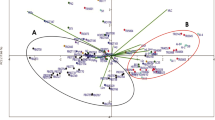Abstract
To revive cultivation of the tea unique to the western Himalayan region, it is important to evaluate the seed-derived bushes available in the area’s abandoned gardens. This study used quantitative leaf characters, catechin content, and AFLP markers to assess these China cultivar type bushes. Compared with other China cultivar germplasm, these accessions showed a higher level of diversity among themselves. Among the quantitative morphological characters, leaf length is important in distinguishing the accessions studied, with a high loading value in the principal component analysis. The catechins and AFLP markers displayed the genetic makeup of the accessions. Other than total catechins, the trihydroxylated catechins showed a high loading value in differentiating the accessions. The genetic control of the ratio of dihydroxylated and trihydroxylated catechins is found to be based on a correlation with AFLP markers. The genetic similarity between Kangra Asha and Kangra Jat suggests that Kangra Jat must be descended from Kangra Asha. Kangra Jat is well adapted to local environmental conditions, as is evident from its high catechin content.


Similar content being viewed by others
References
Balasaravanan T, Pius PK, Raj Kumar R, Muraleedharan N, Shasany AK (2003) Genetic diversity among the south Indian germplasm (Camellia sinensis, C. assamica spp. lasiocalyx) using AFLP markers. Plant Sci 165:365–372
Doyle JJ, Doyle JL (1987) A rapid DNA isolation procedure for small quantities of fresh leaf tissue. Phytochem Bull 19:1–15
Evans JC (1992) Tea in China. Greenwood Press, Westport, pp 1–22
Gerats AM, Martin C (1992) Flavanoid synthesis in Petunia hybrida: genetics and molecular biology of flower colour. In: Stafford HA, Ibrahim RK (eds) Phenolic metabolism in plants. Plenum Press, New York, pp 167–175
Hammer O, Harper DAT, Ryan PD (2001) PAST: paleaobiological statistics software package for education and data analysis. Palaeontol Electronica 4(1): 9pp
IPGRI (1997) Descriptors for tea (Camellia sinensis). International Plant Genetic Resources Institute, Rome
Kaundun SS, Park YG (2002) Genetic structure of six Korean tea populations as revealed by RAPD-PCR markers. Crop Sci 42:594–601
Kaundun SS, Zhyvoloup A, Park YG (2000) Evaluation of the genetic diversity among elite tea (Camellia sinensis var. sinensis) accessions using RAPD markers. Euphytica 115:7–16
Lai JA, Yang WC, Hsiao JY (2001) An assessment of genetic relationships in cultivated tea clones and native wild tea in Taiwan using RAPD and ISSR maskers. Bot Bull Acad Sinica 42:93–100
Lee SH, Choi HS, Kim RS, Lee HY, Nou IS (1995) Identification of Korean wild tea plants and Japanese green tea cultivars using RAPD markers. J Korean Tea Sci 1:129–148
Li HL (1983) The domestication of plants in China: ecogeographical considerations. In: Keightley DN (ed) The origins of Chinese civilization. University of California Press, Berkeley and Los Angeles
Magoma GN, Wachira FN, Obanda M, Imbuga M, Agong SG (2000) The use of catechins as biochemical markers in diversity studies of tea (Camellia sinensis). Genet Resour Crop Evol 47:107–114
Matsumoto S, Takeuchi A, Hayatsu M, Kondo S (1994) Molecular cloning of phenylalanine ammonia lyase cDNA and classification of varieties and cultivars of tea plants (Camellia sinensis) using the tea PAL cDNA probe. Theor Appl Genet 89:671–675
Muraleedharan N (1999) Tea research in South India. Planters Chron 95(10):481–483
Obanda M, Owuor P (1997) Flavonols composition and caffeine content of green leaf as quality potential indicators of Kenyan black teas. J Sci Food Agric 74:209–215
Paul S, Wachira FN, Powell W, Waugh R (1997) Diversity and genetic differentiation among populations of Indian and Kenyan tea (Camellia sinensis (L.) O. Kuntze) revealed by AFLP markers. Theor Appl Genet 94:255–263
Saravana M, Maria John KM, Rajkumar R, Pius PK, Sasikumar R (2005) Genetic diversity of UPASI tea clones (Camellia sinensis (L.) O. Kuntze). On the basis of total catechins and their fractions. Phytochemistry 66(2005):561–565
Sharma V, Gulati A, Ravindranath SD, Kumar V (2005) A simple and convenient method for analysis of tea biochemicals by reverse phase HPLC. J Food Compost Anal 18(6):583–594
Ukers WH (1935) All about tea. Tea and Coffee Trade Journal Company, New York
Vos P, Hogers R, Bleeker M, Reijans M, Van Der Lee T, Hornes M, Frijters A, Pot J, Peleman J, Kuiper M, Zabeau M (1995) AFLP: a new technique for DNA fingerprinting. Nucleic Acids Res 23:4407–4414
Wachira F, Wauch R, Hachett CA, Powell W (1995) Detection of genetic diversity in tea (Camellia sinensis) using RAPD markers. Genome 38:201–210
Wachira FN, Powell W, Waugh R (1997) An assessment of genetic diversity among Camellia sinensis L. (cultivated tea) and its wild relatives based on randomly amplified polymorphic DNA and organelle specific STS. Heredity 78:603–611
Wachira F, Tanaka J, Takeda Y (2001) Genetic variation and differentiation in tea (Camellia sinensis) germplasm revealed by RAPD and AFLP variation. J Hortic Sci Biotechnol 76:557–563
Weatherstone J (1992) Historical introduction. In: Willson KC, Clifford MN (eds) Tea: cultivation to consumption. Chapman and Hall, London
Acknowledgments
We are grateful for financial assistance from the Council of Scientific and Industrial Research, New Delhi, under the NMITLI program and the Department of Biotechnology (Govt. of India).
Author information
Authors and Affiliations
Corresponding author
Rights and permissions
About this article
Cite this article
Karthigeyan, S., Rajkumar, S., Sharma, R.K. et al. High Level of Genetic Diversity Among the Selected Accessions of Tea (Camellia sinensis) from Abandoned Tea Gardens in Western Himalaya. Biochem Genet 46, 810–819 (2008). https://doi.org/10.1007/s10528-008-9195-1
Received:
Accepted:
Published:
Issue Date:
DOI: https://doi.org/10.1007/s10528-008-9195-1




